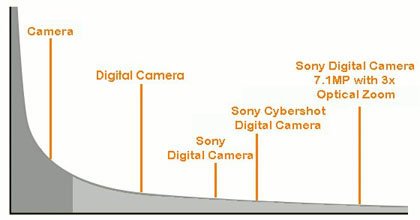Long tail keywords are coming to the fore in terms of people searching for products, services and information. No longer will generic searches, offering thousands of results, suffice. Searching habits are changing and more businesses now recognise the ability for less generic searches to result in improved profit margins.
People assume that loading a website with generic keywords (head terms) such as ‘shoes’, for example, will automatically get thousands of views and in turn, sell a high volume of shoes. However, this couldn’t be further from the truth.
If proof was required, these ‘popular’ search terms only make up roughly 30% of searches performed on the internet, with the other 70% of searches using long tail keywords. Add to this the statistics showing that long tail keywords account for twice as many conversions as ‘head terms’, and there is a particularly strong argument that the implementation and focus on less generic terms will vastly improve sales.
Long tail means more conversions
Therefore, by solely focusing on these head terms, companies may well get a strong number of page views and a lot of traffic to a website, but there will not be a comparative number of sales or conversions to show for that increase in traffic. However, by targeting consumers who know exactly what they want, using more specific terms and keywords on the website will see a higher conversion rate.
SEO is not just about driving a lot of traffic to a website; it is a vital tool which provides the opportunity for a company to improve on sales. It is a method which should be embraced and adopted. Long tail keywords are ‘buyer specific’ whereas ‘head terms’ are traffic specific.
As the graph below shows, people with little interest in what a company is offering are at the top end of the conversion funnel. Here traffic is vast, although there is a severe lack of conversions as the consumer at this point is very vague as to what they actually want to search for.
Conversely, the people at the bottom end of the funnel know exactly what they are looking for and are on the verge of making a purchase. Even though the options are very limited, the specifications are precise, and sales will abound as the long tail is acquiescing to consumer needs and finding the most relevant result for a search.
To use the above example, a person who is using short tail keywords such as ‘digital camera’ will be looking for a number of different branded cameras as well as prices and specifications on the model, or even to find out how digital cameras work, and which models are better for certain aspects of photography. More often than not, people are not even looking to make a purchase, but simply just to have a question answered.
Somebody who uses long tail keywords, such as ‘Sony digital camera 7.1MP with 3x optical zoom’ knows exactly the model they are looking for and the price range within which they are willing to shop.
In a nutshell, long tail keywords usually consist of at least three words and they are more specific for what a person is looking for. These keywords are used when the website wants to refine the search results and provide an accurate result in relation to what is being searched for.
Due to the specific nature of these terms, companies are likely to encounter fewer competitors, as they are one of very few who are optimising for these precise words and terms. The more niche the keyword, the fewer competitors. This in turn will rank the website higher as there are virtually no competitors, given the closely tailored keywords being optimised.
Long tail keywords and content
The great thing is that the optimisation for long tail search terms is so easy to do – although, when looking to use long tail keywords, the same rules still apply as with any marketing strategy. Content is king, and this notion needs to be adhered to more so than ever when working with long tail keywords.
Targeting specific searches means the content needs to be as varied as possible while maintaining its relevance throughout. The fresher and more helpful the content, the greater the likelihood of acquiring a new customer. Start with a simple, well-written blog post about the underperforming word or words that you are targeting.
Search engines are becoming a lot better at satisfying the user through answering their questions. The habits of users are changing. To find what they want, they are no longer putting keywords into Google that yield simple results. Users are now constantly asking Google questions and want their exact queries to be answered.
Once made aware of what the user is looking for, a company can then start on tailoring products, pages and posts to deliver what the users want to know. Obviously, the benefit of this comes when somebody lands on the webpage which answers their specific question.
If a website possesses content that answers these sometimes elaborate questions, there is an extremely high chance that the customer will click on that particular website.
There are a variety of other ways to find the most suitable long tail keywords for a brand, which can then be utilised and maximised. Google auto-suggest is one, as this elicits relevant options for the rest of the search term as it is being typed.
Sticking with Google, the related searches box – which appears at the bottom of the search page, underneath the last organic result – is another good way of seeing what Google considers to be related to your search.
Analysing search terms
There are a number of keyword research facilities that can be used to help that aren’t Google related – such as the wordstream keyword tool and search features within social media, such as YouTube and Twitter. YouTube is the second most popular website that people use for searches after Google.
A lot can also be gained from Google Analytics. Analytics reports are able to inform as to which keywords and phrases lead visitors to a website, which then allows a company to navigate search patterns and trends amongst users and emphasise the keywords garnering the most traffic. Businesses can also strategise for the terms that aren’t performing as well as the others.
Another excellent feature of analytics is that it can go into greater detail, as it is able to break down records and figures for a certain period of time throughout the year. This is extremely handy if a company deals with seasonal products, often showing that users are looking for certain services or products – or for particular snippets of information – at a certain point in the year.
The use and implementation of long tail key words cannot be understated; the benefits are obvious for all to see. Consumers are being directly targeted, having their requirements fulfilled due to the exact responses that are being given. Focusing on these potential buyers who are primed to make a purchase will inevitably increase ROI.
If a company is wondering why it’s not seeing a decent return of profit, then increasing the use of long tail keywords is a great place to start.
- How to find a circular reference on Excel - May 23, 2024
- Five life skills learned from internet marketing - January 3, 2024
- How artificial intelligence can (and can’t) help you write content - September 29, 2023





























The rise of long tail keywords: Long tail keywords are coming to the fore in terms of pe…
RT @rvandenbel: The rise of long tail keywords: Long tail keywords are coming to the fore in terms of pe… http://t…
Our @shaunfrackers writes about longtail keywords and ROI